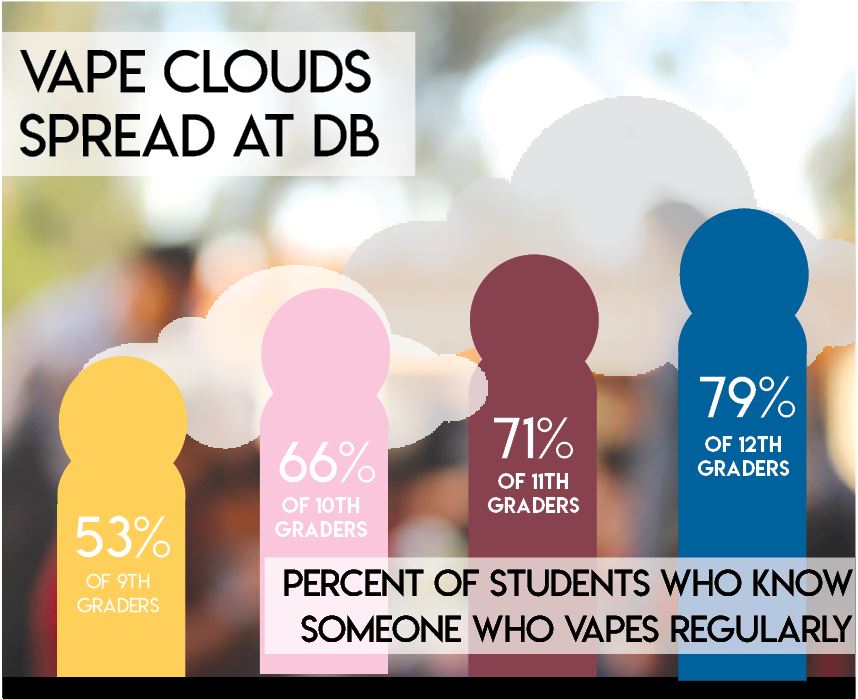Vape Clouds Spread at DBHS

in an anonymous poll, 676 brahmas said
0
%
those found vaping should be punished
0
%
they know someone who vape regularly

a growing student habit
Puffs of flavored smoke permeate restroom stalls as a cluster of students stroll out, hall passes in hand, and head back to third period. A friend is spotted coughing into his elbow after taking too big a hit on his flash drive-shaped device.
Vape has settled into Diamond Bar High School campus culture almost as much as rigorous academics and college anxiety. Those who haven’t done it probably know somebody who has.
“I know that there are a lot of students who vape,” DBHS assistant principal David Hong said. “It’s happening here in our bathrooms, it’s happening in our classrooms, it’s happening out on campus during passing periods.”
Still, few Brahmas are ever caught in action. According to Hong, a fire alarm is occasionally triggered from e-cigarette vapor. But those instances occurred more often when vaping was a fairly new development, and students of recent years have managed to refine their skills when it comes to concealing the activity.
“I tried it a few times [at school] but I don’t see why there’s a need to do it at school,” said one DBHS senior, who requested anonymity. “But my friends have a group and there’s a certain time every day when they would get together to this place and then they would come back.”
The extent of disciplinary consequences for those who are discovered vaping varies depending on what’s in the product—nicotine and THC are prohibited under state education code regardless of legality—as well as whether the student is a repeat offender. Punishments range from receiving an in-school suspension to a home suspension, according to Hong, along with parental notification.
“As classroom teachers, I think it’s really challenging because you want to give students opportunities to work independently on things,” Hong said.
Vape is not a predicament unique to DBHS. In 2015, the CDC reported that almost one in four teenagers vape, and, in 2018, FDA Commissioner Scott Gottlieb publicly called the situation an “epidemic” among American youth.
So what is it about these devices that hooks teenagers? Most e-cigarettes do contain nicotine, though not all. JUUL, a leading provider of e-cigarettes, uses nicotine salts in its pods.
“[I enjoy] the feeling you get when you smoke,” one Brahma senior said. “The nicotine helps you to calm down and relax.”
Some students say they simply find amusement in manipulating the vapor.
“[The fun of it is] having a lot of smoke coming out of your mouth and you could make shapes, like the circles and everything,” another senior said.
Others, however, rely on vape devices to help curb their cigarette addiction. One senior recounted first smoking hookah and cigarettes earlier in her high school career before introducing herself to vape toward the end of junior year.
“It certainly does help me overcome [nicotine] because… when you have a vape you wouldn’t really need cigarettes because it already has nicotine in it and you could [also transition to] those without nicotine in it,” she said. “I don’t vape a lot—probably three times a week—because I’ve been trying to stop.”
These students come closest to fulfilling the intended usage marketed for by major vape companies: employing e-cigarettes as a safer alternative to the real thing. It provides the nicotine dosage without the tobacco, tar or other impurities.
But most high school age e-cigarette users are not looking toward vape as a path to tobacco cessation, as according to a 2017 study by the CDC, about 50 percent more teenagers vape than smoke.
“These companies know… that if they can get you hooked on nicotine when you’re young, then you’ll give them money for the rest of your life,” Hong said. “They’re going after young people because you’re more likely to try this.”
Your donation will support the student journalists of Diamond Bar High School. Your contribution will allow us to purchase equipment and cover our annual website hosting costs.


